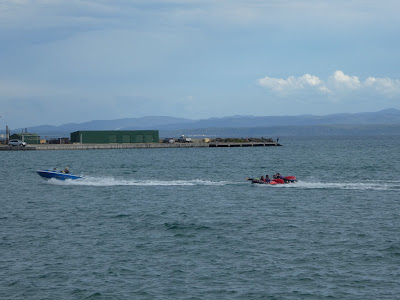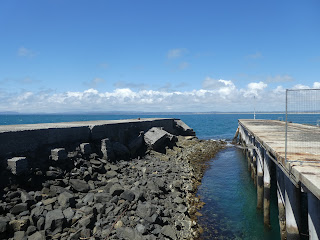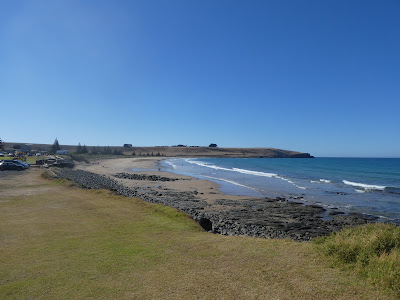As I mentioned in my first blog relating to our visit to Stanley, apart from all else here on the tourist menu, this is a town of two fine beaches, something I suspect has been a little overlooked in the 'history hype'.
The port facilities here also played a crucial role in the development of not only this town itself, but the north-west of the island. Shipping is less important these days, but the Stanley wharves still dock cattle transport vessels and the small cargo tramps which service the nearby islands.
I have decided to take a quick look at this aspect of Stanley life before we again wander back in time,
beginning with another few views of the flat expanses of Tatlows Beach, where the fall of the tide exposes vast tracts of wet sand and a bit of a gallop for any wanting a swim at this time.
And swim they do, weather and tide permitting. This group of overseas visitors was making the most of things as I was wandering about town on a fine and sunny day.
This is a shot I meant to include in our rounds of the Stanley Caravan Park (I couldn't find it at the time) which shows the path leading to the beachfront not far from our site. It led directly to a set of stairs down onto the beach.
This is a typical view across the eastern end of Sawyer Bay in these conditions.
But what a difference a few hours can make. On a high tide the water lapped the rocky barrier below the seafront walkway,
and taking a swim was far more easily done. It was then merely a matter of descending the short stairway to the water and quite a few park residents did just that during our stay.
On evenings of high tides (and relatively calm breezes) ski boats were a common sight on Sawyer Bay,
but I have to quite selfishly comment that this rather noisy intrusion into our afternoon happy hours did not occur too frequently.
The walkway in front our our park continued right around the eastern end of Tatlows Beach past the public park just beyond the the caravan park
and on to the old town dock and boat ramp at the far end of the bay.
We took advantage of this to wander down past the original town dock which is now used as a slipway
and shelters the town small boat ramp.
From here we walked on past a few of Stanley's historical port buildings and apartments (the group of red roofs mid shot....to be included in the town blog) and on to the fishing fleet marina. The smallish building at the shore end of the western wall of the boat harbour
housed the ticket office for the Stanley Seal Cruises (and a cafe of course),
but today rough seas off shore meant that the small cruise boat was to remain safely tucked up within the protective walls of the marina.
A few of the fishing fleet pens were similarly occupied, although it was obvious that some were at sea. This marina is at the mercy of quite variable tides. At the time of our visit the basin was about half full.
Again, what a difference a few hours can make.
Nearby the Stanley Seaquarium combines seafood sales with viewing tanks in which a variety of local sea creatures are displayed.....for a price that is. We did pop in briefly to check out the cost of the fish and crays....and promptly walked out again!
Today access to the main working dock was open to the public,
but this is not always so as this notice we found on the fence next to the gate made clear. On those days when cattle are being shipped out, we would not be welcome. But it did go on to say that this would only be for three hours or so. I found this detail to be quite unusual and a credit to the wharf authorities.
To reach the wharf we passed the seafood processing facilities
where they were hard at it, loading waiting semis with pallets of frozen product.
Once through the gates we found ourselves on the broad and rather rough expanses
of the main wharf which is protected from the worst of the weather by a long breakwater wall,
and even although today's weather could best be described as mild, there was still a fair slop washing in from Bass Strait.
As I stood at the end of the dock looking back at the sheer side of the Nut towering above,
I saw that the north-easterly breeze driving this short chop was clearly being enjoyed by a feathered Stanley local which was wheeling with gay abandon on the currents and eddies of the wind as it bounced off the side of the Nut.
"And who said you could have all this fun to yourself?" These two entertained us for quite some minutes with an aerial display which made us envious of their ability to master the skies.
 Other locals seemed equally at home in the conditions, trying their luck from a wharf which is usually productive for those properly equipped with both rigs and patience.
Other locals seemed equally at home in the conditions, trying their luck from a wharf which is usually productive for those properly equipped with both rigs and patience.
This main cattle loading dock was obviously empty on the day of our visit, but not so the adjoining wharf where a small coastal front loading barge was taking on cargo.
I had not come bearing rods and reels, and my nearest and dearest has a decidedly short attention span when it comes to chatting about rigs, baits, tides and catches, so our sojourn on the main wharf was, for yours truly, unusually brief
before we made our way back past the Seaquarium,
the large cool store on the other side of the road,
and back into town where we did stop at the large and very well organised Hursey Seafood premises at the junction of Wharf Road and Alexander Terrace.
Here a wall photo gave us another view of the marina, the cold store and the fish processing factory with the old dock and boat ramp in the distance.
This same wall also listed the price of the 'fruits de mere' on offer. Stanley seafood is generally reputed to be without equal in Tasmania. Our Rosevears friends had waxed lyrical about the taste of Stripey Trumpeter, and we needed no persuasion about the delights of Southern Rock Lobster.
We had not salivated over fresh cray this Xmas as we had done in the past few years, both back in Adelaide and whilst in the West. It was time for a seafood feast, and hang the expence.
No chat about Stanley beaches would be complete without reference to sands of Godfreys Beach on the opposite side of the peninsula to Tatlows, viewed here from the chairlift
and here from the park at the southern end of the beach (again we'll see more of this during the town tour).
It is Godfreys Beach which features in what I suspect is one of the most photographed views of
Stanley, one taken, as I did, from the hill at the front of Highfield House looking south-east to the Nut.
Finally, on the subject of local beaches, let me conclude with two more photos, this of the southern end of Tatlows Beach, with two homes on the hill which could not be more different (and a mobile version making its way into town),
and this, taken from the Nut, a close up of the beach of the Eastern Inlet (which is really an
extension of Tatlows. In fact, if so inclined (and we were too busy to do so), these beaches offer magnificent walks for several kilometres. This shot also shows the waters of the Western Inlet on the far side of the narrow isthmus which carries the road from the Bass Highway into Stanley.
Now the story of this day would not be complete without a postscript, when Chef Pierre repaired to the galley to clean the cray
and cook the Stripey.
I would like to be able to say that I've not included a photo of the end result because we did not want to create too much envy......the truth of the matter is quite different. Having popped the cork of a chilled bottle of the last of our local Frogmore Creek Pinot Gris, we were too damned busy tucking in! The Stanley seafood reputation remains unsullied as far as we are concerned.









































No comments:
Post a Comment